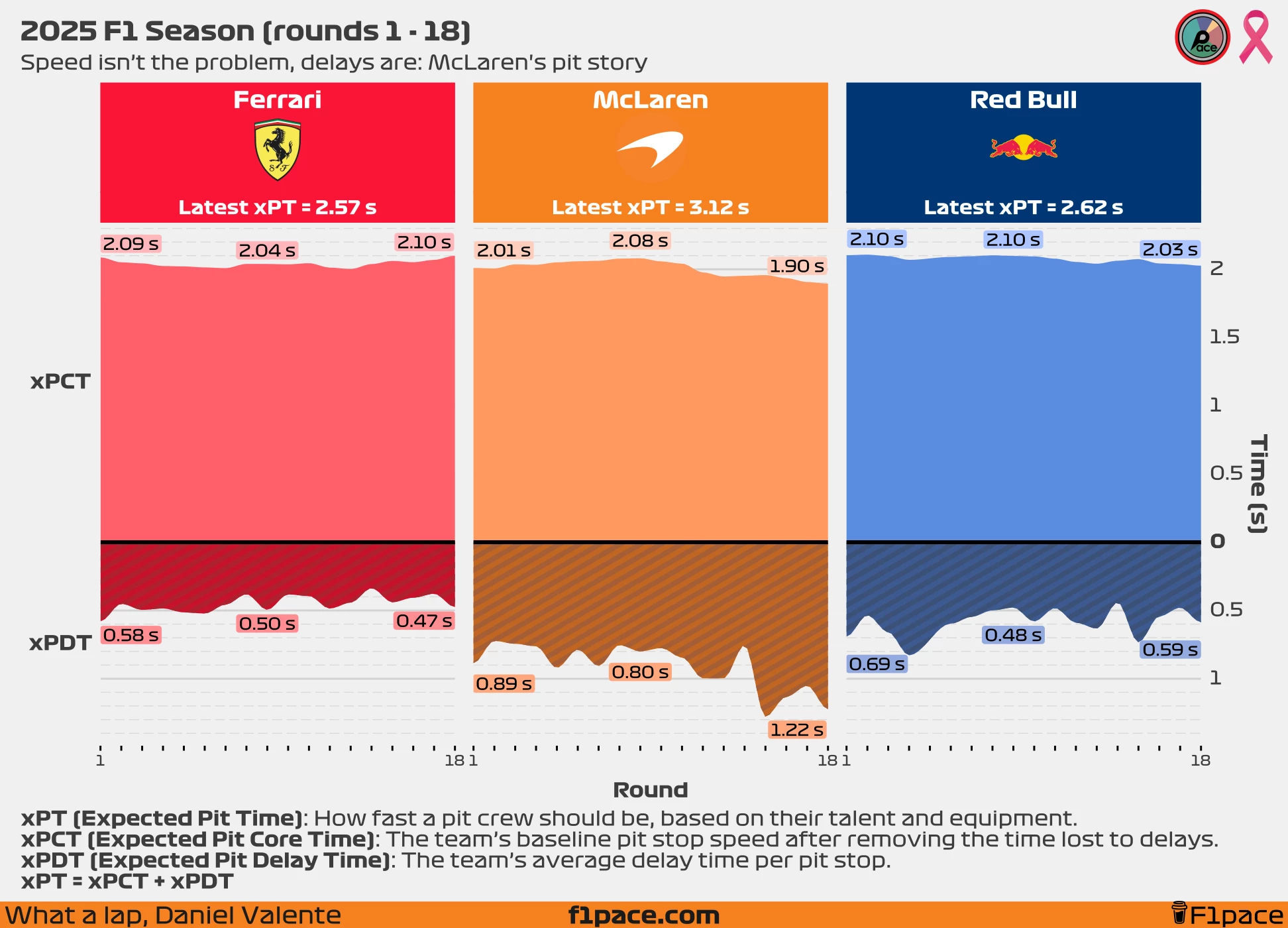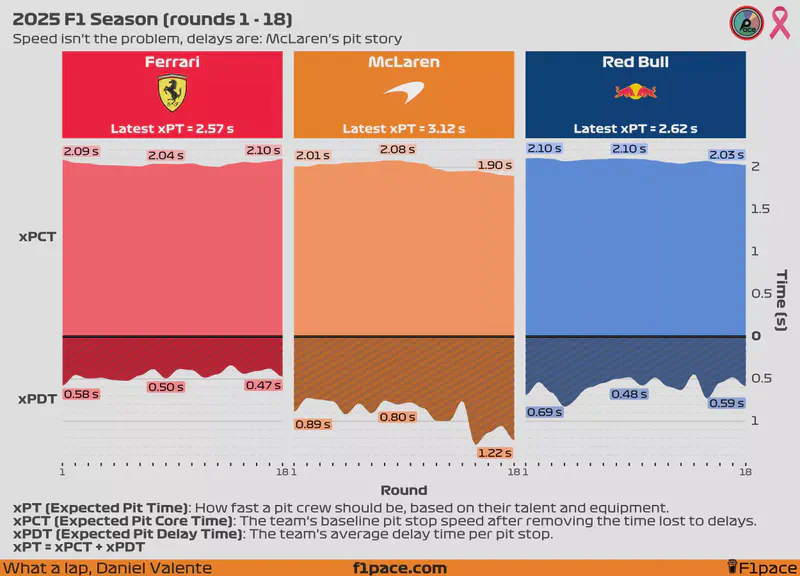This short post takes a closer look at McLaren’s pit stops and the trends we’ve seen from them during the 2025 season. It’s a follow-up to my previous piece, Pit Stop Power Rankings (Rounds 1–18), but this time we’ll dig deeper than just average results. Using our statistical model, we’ll explore how McLaren, and the other two benchmark teams from recent seasons, are evolving as the season unfolds.
Use the Get in touch link if you’re interested in supporting this project.
Speed isn’t the problem, delays are

Looking at our chart, the gap between McLaren and this season’s top two pit stop performers, Ferrari and Red Bull, is clear. Ferrari currently boasts an expected Pit Time (xPT) of 2.57 seconds per stop, while Red Bull sits at 2.62 seconds. In contrast, our model projects McLaren’s average stop at 3.12 seconds, roughly half a second slower than Ferrari and Red Bull.
So, where does this difference come from?
Our model breaks down xPT into two components. The first is xPCT (expected Pit Core Time), which reflects a team’s baseline speed by stripping away average time lost to fumbles, hesitations, and other minor mishaps. The second is xPDT (expected Pit Delay Time), which measures the average delay added on top of that core speed—essentially, the time penalties teams pay for those inevitable interruptions during the pit stop process.
xPCT
Focusing on xPCT gives us a clear view of the raw pit stop speed each team has shown over the season. Here, McLaren stand out as the outright fastest crew in Formula 1. They hold the three quickest stops of the year, and when they’re in the zone, they really deliver. Not only are they the benchmark in this category, but they’ve also gotten quicker as the season has progressed—most notably with a sharp improvement after the summer break. Red Bull and Ferrari follow, around one and two tenths slower respectively, and while both are exceptionally quick, neither has matched McLaren’s pace in this department.
xPDT
When we turn our attention to xPDT, the story shifts completely. Ferrari’s pit crew have been models of consistency, keeping their delays short and trending in the right direction throughout the season. They began the year with an xPDT of 0.58 seconds per stop and have trimmed that down to 0.47 seconds by the final race. Red Bull have followed a similar upward curve, improving from 0.69 to 0.59 seconds per stop by round 18.
McLaren, however, tell a different story. They not only trail Ferrari and Red Bull in this metric but are now several steps behind. Their season started with an average xPDT of 0.89 seconds per stop—already about 50% slower than Ferrari and nearly 30% slower than Red Bull at that stage. Unfortunately, things have only worsened, with their xPDT ballooning to 1.22 seconds per stop in the final quarter of the season. That’s roughly two and a half times slower than Ferrari and twice as slow as Red Bull. Unlike their rivals, who have refined their processes and boosted consistency, McLaren appear to be moving in the opposite direction, struggling more as the season goes on.
Summary
- 🔴 Ferrari: Consistently quick with minimal delays. Fast in every way.
- 🟠 McLaren: Fastest potential with an xPCT of 1.90s, but delays of 1.22s per stop.
- 🔵 Red Bull: Steady performance with xPT at 2.62s. Strong in xPCT and xPDT.
McLaren’s xPCT (Expected Pit Core Time) shows they have the talent to execute sub-2 second stops. But when delays hit due to equipment issues, positioning problems, or coordination errors, they lose over a second per stop.
Conclusion
What this all tells us is that McLaren have the fastest pit crew in Formula 1 when it comes to pure speed—but that speed isn’t translating into overall pit stop efficiency. Their xPCT shows they can reach incredible times when everything goes to plan, yet their rising xPDT reveals a growing problem with delays and execution.
Ferrari and Red Bull don’t quite match McLaren’s peak pace, but they’ve mastered consistency, steadily improving pit stop reliability as the season has gone on. That’s where the real advantage lies: cutting out errors and keeping delays to a minimum.
McLaren’s situation is puzzling considering Andrea Stella has openly acknowledged they’ve identified the root causes of these issues, both in the human element, and in the complexity of their pit stop hardware. Yet despite this awareness, the numbers paint a worrying picture: delays have increased dramatically in the final stretch of the season. In theory, knowing the problem should help stop the bleeding and allow them to improve, but in practice, McLaren’s execution has been slipping further away from their rivals.
Support this project
This piece builds on the Pit Stop Power Rankings (Rounds 1–18), which remains the most detailed analysis I’ve published here so far. Doing inference with statistical models isn’t easy—it takes a lot of time, testing, and refinement to create something that produces reliable, meaningful insights. Developing this model initially took weeks of focused work, and I continue to work on it to improve it as the season goes on.
If you’ve enjoyed reading this article, please consider becoming a supporter. Your support truly makes a difference and helps me keep creating in-depth, data-driven F1 content like this. Thank you for reading and for being part of this growing community.
